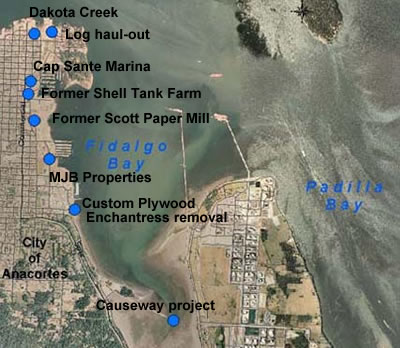
When environmental cleanup projects around Fidalgo Island are completed in about two years, the total cost will end up around $50-million, with the state paying about one-half the cost and landowners paying the rest.
Through the Puget Sound Initiative, Washington State has committed the resources and funding for a healthier Puget Sound and surrounding communities. The Puget Sound Initiative is a collaborative effort – by local, tribal, state and federal governments, business, agricultural and environmental interests, and the public – to restore and protect the Sound.

A leading source of pollution to the Sound is contaminated sites around its shorelines. Ecology's Toxics Cleanup Program has identified contaminated sites within one-half mile of the Sound. In response to the Puget Sound Initiative and increased funding, Ecology has accelerated its efforts to clean and restore contaminated sites within identified priority bays. These areas are the cornerstones of Ecology's approach to protect and restore Puget Sound.
Cap Sante Marina ($2-5-million)
The Cap Sante Marine Site has been operated as a boat yard and marina support area since 1959. In the early 1980s, fuel was observed seeping from an underground storage tank into the waters of Fidalgo Bay next to the site. Fuel was recovered and the seepage was stopped. But, however, impacted soils linked to the prior petroleum leakage were not removed.
The Port of Anacortes, the current owner is entering into an Agreed Order with Ecology who will remove the USTs and any contaminated soils. Future plans for the site include construction of a new dry storage and boat launch. Along the shoreline, public access has already been improved by a walkway, built into the overall marina.
Custom Plywood ($2-7-million)
This waterfront site was used as a mill and box factory. The site is currently undergoing cleanup work. A sawmill and wood-box factory, and then a plywood mill, operated on the site for almost a century.
Dakota Creek ($3-4-million)
The site is currently an active shipyard, used for the construction and repair of vessels. Historical uses at the site have resulted in soil, groundwater, and sediment contamination.
Former Scott Paper Mill ($22-26-million)
This is by far the largest and most expensive cleanup in Fidalgo Bay. A lumber mill, and later a pulp mill operated on the Scott Paper Mill Site beginning in the late 1800s through the late 1970s. The pulp mill used waste from the lumber mill and discharged waste water directly to Fidalgo Bay. Metals, diesel- and motor oil-range petroleum hydrocarbons, carcinogenic polynuclear aromatic hydrocarbons (cPAHs), polychlorinated biphenyls (PCBs), and dioxins/furans have been found in soil at the Site above Washington State cleanup levels. Many of these contaminants were also found in groundwater (low levels) and marine sediments. In 1999, the Port of Anacortes and Sun Healthcare Systems conducted an independent cleanup action to remove petroleum-contaminated soil and wood debris on one of the parcels within the Site. Portions of the property have been operated recently by multiple entities that have used the Site as a log yard, a staging area for oil field equipment, a boat manufacturing site, storage, and a modular home assembly area. The northern portion of the Site is now primarily Seafarers’ Memorial Park, and the southern portion is primarily vacant.
Former Shell Oil Tank Farm ($2-3.55-million)
The Former Shell Oil Tank Farm was used to distribute gasoline, diesel, oil, and other chemical products. Gasoline, diesel, and heavy oil contamination has been found in soil and groundwater samples collected around the site. The amount of contamination in the soil samples was above Washington State cleanup levels. Six above ground storage tanks were removed from the site in the 1980’s, and soil was removed in 1987 and 2007. However, the amount of remaining contamination is unknown. The site is currently used for boat trailer parking.
March Point Landfill ($3-6-million)
The March Point Landfill, sometimes called the Whitmarsh Landfill, operated from 1950 to 1973. It initially served as an unregulated dump, and later as a county disposal area. Household, commercial, and industrial wastes were dumped at the site. Marine sediment samples show contamination from metals, phthalates, phenols, polycyclic aromatic hydrocarbons (PAHs), dioxins, and furans. Surface and seep samples from the landfill show contamination from metals (including arsenic, lead, copper, and mercury), petroleum compounds, and polychlorinated biphenyls (PCBs). Snow Mountain Company currently operates a sawmill on the Site. Further study is necessary to fully characterize the contamination at the Marsh Point Landfill.
Fidalgo Bay Causeway Study ($160,000)
The Samish Indian Nation is using money from the Washington Department of Ecology (Ecology) to study how an old railroad causeway may impact habitat in Fidalgo Bay in Skagit County.
The tribe will lead a remedial investigation and feasibility study on part of the 3,300-foot recreational Tommy Thompson Trail extending over Fidalgo Bay. The trail stretches from tribal property at Weaverling Spit to March Point. Originally, the entire length was a trestle made up of creosote pilings. At some point, 1,500 feet of rock causeway was placed over roughly half the creosote pilings; 770 pilings remain, leaching into the marine environment. It’s not known if the causeway contains other materials. The Samish believe removing the rock causeway and existing creosote pilings and replacing it with a more open, environmentally friendly support structure that continues to serve the public, will help improve eelgrass habitat by restoring more natural water flow and removing potential contamination. The City of Anacortes must approve any work beyond the investigation and study.
Other projects
- Pier 2 Log Haul Out ($1-2.2-million)
- MJB Properties-central/south ($250,000-1.5-million)
- Fidalgo Bay Sediments Study ($400-550-thousand)
- Derelict Vessel Enchantress Removal ($400-500-thousand)
Total Cost: $38.55-55.55-million
